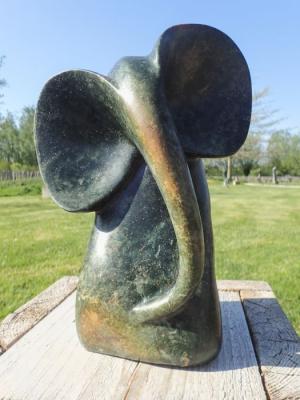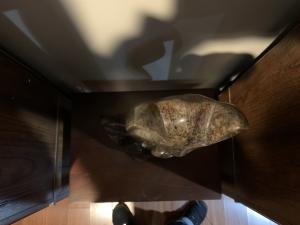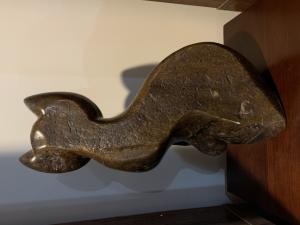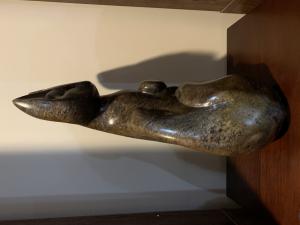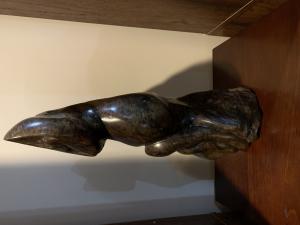Posing Cat
Tariro Johahane Mashaire
Sculpture
An elegant sculpture of a cat with which Tariro Mashaire continues his brother’s and teacher’s, (Taurai Mupaso’s) thematic preoccupation with common animals. Taurai is known in Harare as the “Owl-man” and creates sculptures almost exclusively of owls (ID 38, 39) in an attempt to shift the local perception of these nocturnal creatures from their traditional association with witchcraft and evil, to a friendlier and more sympathetic one. Works by his younger brother focus mostly on depictions of cats, ducks and owls, amounting to an interesting juxtaposition of rather commonplace animals that in this way become elevated to a higher, even spiritual status, assuming a kind of totemic quality.
Stone carving has been a part of Zimbabwean culture since the 1200s and re-emerged as a modern sculptural tradition in the 1950s, known as the “Shona movement”. The driving force behind this art renaissance was Frank McEwen, director of the Rhodesia National Gallery from 1957 to 1973. McEwen encouraged and supported aspiring artists as they started the movement that would quickly become world-renowned. International collectors and critics were amazed at the rigour, spontaneity and originality of the works coming from an area of Africa which had none of the great sculptural heritage of West Africa and had been previously described as rather barren in terms of its visual arts. Contrary to other artistic tendencies and movements coming out of Africa in the post-colonial period, Shona sculptures were not looking back at the tradition of functional sculptural objects inspired by traditional customs and rituals, rather they found their sources in the present and created sculptures that blend the contemporary moment with the memories and dreams of their tribal past (the so-called “tribal consciousness” that was thematically encouraged by McEwen). Up to today, artists, without preliminary studies, spontaneously carve out semi-abstract shapes of birds and other animal or human forms imbued with ancestral symbolism, expressing an integral part of present day Shona folklore and religious beliefs.
Height: 17.5”
Width: 9”
Depth: 6”
inches
Phoenix, AZ
Chitungwiza Arts Centre, Zimbabwe
*Technique: These Zimbabwean sculptures are made strictly with hand, no power tools are used at any stage of the process and generally, everything is created free-form, ie. there are no preliminary sketches. The tools consist of hammers, points, chisels, rasps and chasing hammers, and the finishing of each sculpture takes almost as long as the process of creating it. The smooth effect is achieved by “washing” the sculpture, using wet and dry sandpaper and if the artist wants a high polish on the stone, the stone is heated and covered with wax (for a more detailed description of the sculpting process, see ID 48)
*Material: This sculpture is most probably carved out of fruit serpentine, a colourful variety of the traditional Zimbabwean serpentine stone that mostly comes from the Kwekwe area, south-west of Harare. Fruit serpentine is usually a very colourful, pretty stone, with deep veins of layered colours. Alternatively, it could be carved out of green opal stone, another very common, soft, greenish type of serpentine, that Tariro is known to work with as well (see above, his sculpture of an elephant, carved out of green opal for comparison - the difference between fruit serpentine and opal stone can be best seen in sunlight). Opal stone is one of the favourites of sculptors as it is not as hard as springstone and other serpentines, but still polishes to a high finish. It can have a darker, brown colour throughout the predominate greens.
Tariro was born in 1990 in Zimbabwe. When he was 15, he started working with his brother, Taurai Mupaso, at the Chitungwiza art center, polishing his sculptures and gaining valuable experiences. Soon he started sculpting on his own. He most enjoys sculpting animals - cats, ducks and owls - in different kinds of stone. In 2010 he won the Bernard Matemera incentive award. He currently works at the Chitungwiza Arts Centre.

